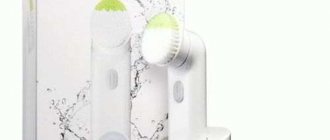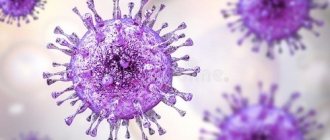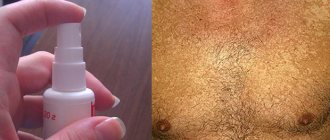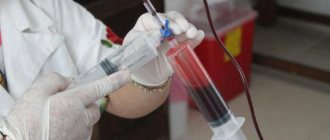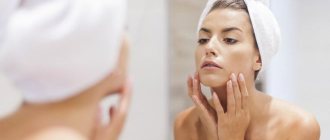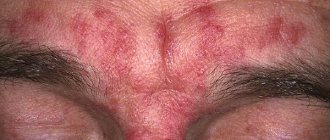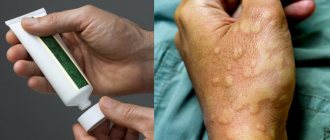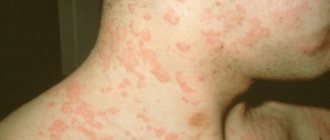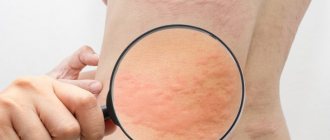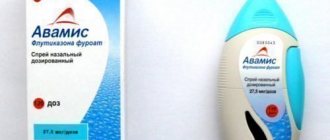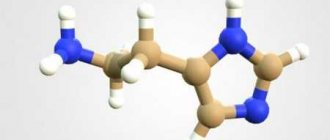Causes of urticaria
The key cause of hives is an incorrect immune response of the body to a certain irritant.
List of medications for Urticaria
List of medications for Urticaria in the photo
List of medications for Urticaria
List of medications for Urticaria in the photo
List of medications for Urticaria
When a provoking substance enters the body, the latter begins to release an increased amount of histamine and some other elements. These substances increase the permeability of small vessels and swelling of skin tissue, which leads to severe itching and the formation of superficial inflammation.
Provoking factors may be:
- food and medications (photos of urticaria for medicine are available online);
- temperature changes, water, solar radiation, wind;
- tight shoes and clothing;
- wool and fluff;
- bee products;
- stress;
- household and cosmetic products (in this case, you should be most careful with ointments for allergies and urticaria).
Above are the most common options. In each specific case, the doctor identifies the cause and selects the most suitable medications for urticaria.
There are urticaria of a non-immune type. Pathology develops against the background of some other diseases. The risk group includes people with the following problems:
- renal and liver pathologies (especially chronic);
- tumors;
- bacterial, viral or fungal diseases;
- endocrine problems, hormonal imbalances;
- parasites;
- pathologies of the gastrointestinal tract.
The causes and course of development of urticaria are difficult to identify. Therefore, the sooner the patient goes to the hospital, the better.
Ointment for itching in urticaria: how to relieve the symptom at home
Ointments for urticaria in adults with itching and rash can be purchased at a pharmacy without a doctor's prescription, but despite this, self-medication with external agents is unacceptable. Medicines differ in composition and are hormonal and non-hormonal.
The first ones quickly relieve itching and other signs of allergies, but they have many contraindications and unwanted reactions. Among the advantages of non-hormonal drugs, it is worth noting the absence of addiction, a minimal number of contraindications and side effects.
What is urticaria, signs
Urticaria is a group of skin diseases characterized by the manifestation of allergies. This produces round blisters with raised reddish edges and a pale center. Accompanied by severe itching.
Skin pathology develops due to external factors (physical, chemical) and internal (nervous system disorders, body diseases). There is an idiopathic form when the source cannot be identified.
Provoke an attack:
- burns of various etiologies;
- allergies to food, drinks, medications;
- bites of ants, bedbugs, mosquitoes;
- inhalation of allergens;
- sudden cooling, overheating;
- pathologies of the liver, kidneys;
- infections;
- heredity.
Toxicosis in pregnant women and stressful situations can also develop the disease. The disease is characterized by the following characteristics: multiple bright red rashes with white spots, dense blisters with marked boundaries. Their sizes range from a few millimeters to a continuous cover.
Depending on the severity of the disease, the following are distinguished:
- acute urticaria (redness, pink blisters with a diameter of 1 cm or more);
- chronic (light pink rashes);
- accompanied by Quincke's edema (swelling of the skin and mucous membranes).
Sometimes the disease is accompanied by headache, nausea, drowsiness, weakness, and fever.
Types of ointments
Let's look at the most popular remedies that doctors recommend in the fight against such an ailment as urticaria.
Ointments for the treatment of the disease are prescribed:
- Hormonal. The main advantage of these means is the speed and effectiveness of the impact. In the shortest possible time they will relieve unpleasant symptoms. Hormonal ointments are intended mainly for adults. Children are not recommended to use such drugs. However, it should be remembered that hormonal ointments have multiple contraindications and can lead to side effects. Sometimes such manifestations can be quite serious: disruption of the functioning of the cardiovascular and endocrine systems, damage to the kidneys and liver. Therefore, hormonal drugs are used only in short courses.
- Non-hormonal. These drugs are safe and accessible. They do not cause serious side effects. They can be used for a long period. But they have a rather serious drawback - they provide an extremely weak therapeutic effect.
Hormonal ointments, according to the strength of their effect, are divided into several groups:
- weak drugs: “Hydrocortisone”, “Prednisolone”, “Flucinar”, “Sinaflan”;
- medium ointments: “Ftorokort”, “Afloderm”;
- strong medications: Elokom, Advantan, Celestoderm, Lokoid;
- extremely strong ointments: Dermovate, Cloveit.
Common non-hormonal agents are:
- "Fenistil gel";
- "Psilo-balm";
- "La-cree";
- "Gistan";
- "Nezulin";
- "Skin cap."
Homeopathy and other external remedies
To cure urticaria, it is necessary to increase the body's resistance to various irritants and food allergens. Hives are an allergic reaction that can only occur when the immune system is not functioning properly. Therefore, walks in the air, hardening and other procedures that help strengthen the immune and nervous system are necessary.
In homeopathy, drugs that calm the nervous system are widely used to treat urticaria. The more stable the central nervous system, the better the immune system works. It is recommended to use infusions of mint and motherwort. You can use stinging nettle infusion instead of tea.
Soothing baths will help deal with the rash. It is recommended to bathe in bran decoction. To do this, you will need to boil 2 kg of wheat bran in 7-8 liters of water. Cool to a comfortable temperature, strain and take a bath for 30 minutes.
Ice cubes obtained by freezing green tea will help eliminate slight swelling at the beginning of the rash. They wipe the affected areas several times a day. Cold constricts small blood vessels, so swelling is reduced.
How to treat the disease
Some patients call all external dosage forms, including gels and creams, ointments. In fact, they differ from each other in the composition of the base and indications.
In creams, medicinal substances are dissolved in water and oil, so the drugs are quickly absorbed. But at the same time, the products do not penetrate very deeply into the tissues, and they evaporate quickly. But the cream can be applied to wet areas of the skin for urticaria.
Ointments contain a large amount of fat, so they are slowly absorbed, but compared to other external dosage forms they penetrate deeply into the tissue. They are not recommended to be applied to wet areas of the skin.
The gels do not contain oils or fats, and are produced using an aqueous base, to which gelatin, glycerin and other components are added to facilitate the penetration of the medicine into the tissues. They are suitable for patients with dry skin as they moisturize, nourish and protect the skin.
How does the disease progress?
Urticaria is usually allergic in nature. This is skin dermatitis, the body's reaction to irritants. Red spots form on the skin of an adult or child. The discomfort is not only an aesthetic inconvenience, but also that the rash is very itchy.
The pathology must be treated, and contact with the allergen must also be minimized or eliminated.
Overdose and storage conditions
Long-term, frequent and incorrect use of an external product, in violation of the instructions, can lead to a high concentration of the active substances of the drug in the body and, as a result, to intoxication.
As a result of an overdose, the patient is characterized by increased excitability or, conversely, lethargy, drowsiness, and confusion; There is an increase in irritant skin reactions (itching, redness).
If signs of overdose appear, you should immediately stop using the ointment and seek medical help..
Treatment of urticaria simultaneously with two or more external agents is selected and prescribed only by a doctor.
A change in the color, smell or consistency of the ointment indicates expiration or improper storage of the product . Such a drug has most likely lost its healing properties and is unsuitable for treatment.
Medicines must be kept in a dark, cool place, out of the reach of children . Discard after expiration date.
Ointment "Gistan"
The medicine is an excellent non-hormonal remedy. However, it should be distinguished from Gistan N ointment. The latter contains hormonal ingredients. Therefore, it is recommended to use this ointment for urticaria in adults.
The medicine "Gistan" consists of natural ingredients: calendula, string, lily of the valley, birch buds. This product is allowed to be used even for children. The drug perfectly eliminates the negative symptoms of urticaria. Widely applicable for any age group.
The only limitation of this product is individual intolerance to the ingredients.
Making ointment at home
To eliminate itching, use ointments prepared according to home recipes. They should have a calming effect, moisturize the skin, and improve metabolic processes in cells. You cannot use “shock” methods, for example, nettle brooms or other means that irritate the body.
When wondering what to apply to a child’s hives, you can prepare a medicine based on St. John’s wort. You will need 100 g of dry St. John's wort without roots.
It is necessary to grind the herb to powder and pour in 1 liter of vegetable oil, olive oil is better. To infuse, the mixture is placed in a warm, dark place for one week. Then you need to strain the product.
Lubricate the affected areas with hives 2-3 times a day.
The potato remedy will help cool the skin and relieve itching. It is necessary to peel raw potatoes and grate them on a coarse grater. Spread the resulting mass onto the affected areas of the body and cover with cling film for 30-40 minutes.
Diagnosis of urticaria
First of all, the doctor asks questions about the manifestations of the disease and examines the patient’s body:
- The specialist finds out the possible causes of the rashes, the frequency of their occurrence, localization features, prevalence and duration (this helps determine which medicine for hives will be most effective).
- The severity of manifestations and characteristics of formations (shade, presence of edema, shape and size) are examined.
- The patient is asked about the presence of urticaria in close relatives and chronic diseases.
List of the best drugs for urticaria
The best drugs for urticaria
List of the best drugs for urticaria
The best drugs for urticaria
If an allergic type of pathology is suspected, an allergological examination is prescribed. Specialists perform samples with potential allergens.
Provocative tests may be performed. For example, applying ice to the skin if cold urticaria is suspected, prick testing (prick testing), patch testing and intradermal tests.
If the allergic nature of the pathology is confirmed, further diagnosis is not required. You can immediately proceed to treatment.
Otherwise, urticaria is secondary in nature and occurs against the background of another pathology. With such urticaria, drug treatment will be completely different. And the examination of the patient will be more comprehensive.
The patient may be prescribed:
- general blood test;
- biochemical analysis of blood composition;;
- general analysis of urinary composition;
- analysis for hepatitis B- and C-types;
- analysis for the presence of syphilis;
- blood examination for the amount of immunoglobulin E (IgE);
- examination for the presence of parasites in the body;
- Ultrasound and x-ray of organs;
- Gastroscopy (FGDS);
- electrocardiogram (ECG).
When examining the blood composition, urticaria is indicated by an increase in ESR and leukocyte volume, coupled with a decrease in the number of red blood cells. For hives, medications for treatment may depend on these factors.
Find out more
Symptoms of urticaria
With the development of urticaria, pathological symptoms may appear within a few minutes, but may also appear after several hours or days.
Doctors call the main symptoms of this pathological process:
- The first symptom is severe itching;
- After this, swelling and rashes of oval blisters, pale pink in color, appear;
- At the sites of the irritant, the skin turns red and painful swelling appears;
- In the absence of medical assistance, the blisters merge with each other into irregularly shaped plaques, turn white, and an inflamed border remains along the edge;
- Body temperature may rise and the patient’s general condition worsens;
- Quincke's edema and anaphylactic shock.
Particular attention should be paid to symptoms such as increased body temperature. It can rise to 39 degrees, the patient is bothered by bouts of fever and even febrile seizures, vomiting and chills.
Treatment methods for urticaria
Drugs for urticaria, both in children and adults, are the main therapeutic measure.
In general, the following areas of treatment are distinguished:
- Products for external application. They include anti-allergenic, soothing and moisturizing ointments, gels, and creams. Many of them are sold without a prescription. In some cases, the doctor may prescribe hormone-containing ointments. For different forms of urticaria, ointments for treatment may differ.
- Internal medications. These include antihistamines, desensitizers, corticosteroids (the best treatment for hives in severe cases), and drugs to improve adrenal function. In case of acute pathology caused by food or medications, laxatives and hyposensitizing drugs may be prescribed. It is worth noting that tablets are prescribed against urticaria more often than other forms.
- Physiotherapy. Ultrasonic exposure, ultraviolet irradiation, Darsonval treatment.
- Multivitamins. To improve immune function. Often complementary to drug treatment for cold urticaria.
- Diet. Compiled individually by the treating doctor. Aimed at eliminating provoking substances from the menu and strengthening the body’s protective functions.
As a rule, all means are used in combination. However, their use depends on the individual case and should be strictly according to the doctor’s indications.
What to do first
At its core, urticaria is an allergy. Therefore, at the first symptoms of urticaria, it is necessary to immediately take some actions:
- take an antihistamine;
- if it manifests itself in a severe form, medication with glucocorticosteroids is also necessary.
Basic medications that should be in any home medicine cabinet for allergy sufferers are antihistamines and hormonal agents to relieve symptoms. Antihistamines: citrine, alerzine, aleron, loratadine, diazolin, suprastin. Glucocorticosteroid drugs: Flix, Flixotide, Avamis. Treatment of urticaria also involves removing toxins from the body. Since the rash appears due to the fact that the pancreas has not coped with its work and thus gives a signal that not everything is in order in the body. Therefore, a person who constantly has rashes should also have enterosorbents in their first aid kit:
- polysorb;
- filtrum;
- enteros-gel;
- white or black coal.
To relieve itching and inflammation of the skin, there are many ointments that almost immediately relieve symptoms: fenistil gel, hydrocortisone, cutivate, prednisolone, diprosalic, triderm.
Avamys is a glucocorticosteroid drug
Ointments for urticaria
Ointments against urticaria are the main therapeutic measure for mild cases of the disease and an auxiliary measure in more complex cases.
Here are some drugs indicated for urticaria:
- Soventol. An ointment for hives on the skin that relieves itching and swelling. Also available in gel form. Not recommended for long-term use - it leads to fatigue.
- Akriderm. Akriderm is used for urticaria as an antipruritic and anti-inflammatory agent. Relieves redness. Has average speed of action. It is used in short courses (total duration up to six weeks). After the symptoms go away, stop using the drug and concentrate on other drugs. The product is available in two forms - ointment (for dry skin) and cream (for rashes complicated by discharge).
- Zinc. This ointment for urticaria is especially recommended for children. Can be used during pregnancy and lactation. It is harmless and does not contain hormones. The main effect is antimicrobial. However, the product successfully fights inflammation. It is important to consult a doctor before use, as the product may cause additional allergies.
- Nezulin. Gel cream for urticaria. Made on a plant basis. Fights against swelling, itching and redness. It has no side effects.
- Celestoderm. Corticosteroid drug (hormonal). Used in severe cases. Often prescribed as an ointment for solar urticaria.
All medications are prescribed by the doctor after a thorough examination of the patient. Ointments for urticaria in adults may differ from children's remedies.
First aid for hives
When a rash occurs in children, the first action is to eliminate the allergen or extremely limit contact with it. If food is the cause, the stomach should be rinsed. If you are allergic to chemicals, cosmetics, or matter, take a shower; if you are allergic to medications, stop using them and replace them with others.
Timely provision of first-aid to a child with urticaria is of great importance in preventing the worsening of the disease.
If urticaria occurs in children: emergency care, the algorithm of actions is as follows:
- When initial signs of manifestation occur, it is important to assess the patient’s condition.
If a single rash is localized, it is slightly itchy and does not enlarge subsequently, it is enough to treat the area with an allergic ointment (Fenistil, Zinc). The drugs effectively eliminate itching and have a drying, astringent effect. Also give him an antihistamine tablet.
- Drink enterosorbent (Polysorb, Activated carbon). Sometimes, the use of fast-acting laxatives (Magnesium sulfate) becomes an effective measure. However, it is necessary to replace the lost fluid.
- A preventive measure for anaphylaxis at the time of an insect bite is the immediate removal of the sting and prevention of the distribution of poison into the blood. Place ice on the bite area. When there is a history of complex allergic manifestations, take an antihistamine (Suprastin, Diazolin).
First aid for rashes and its complications is performed depending on individual symptoms. Therefore, eliminating weak signs of disease with strong doses of steroid medications is very unwise and dangerous.
Tablets for urticaria
There is no best cure for hives. In each specific case, a different drug will be effective.
The following drugs against urticaria are among the most common:
- Suprastin. A sedative and first generation antihistamine. Blocks histamine-sensitive receptors. It is fast-acting. Requires frequent use throughout the day.
- Claritin. Claritin for urticaria is a second generation antihistamine. It is often prescribed to adult patients with a tendency to swelling, as well as those suffering from bronchial asthma. The product has proven itself in cases of intense itching and profuse redness.
- Dexamethasone. Dexamethasone for urticaria has positive reviews. This is a potent hormonal drug based on corticosteroids. Aimed at eliminating redness and itching, improving skin tone and eliminating minor rashes. It has many side effects, including migraines, sleep problems and liver failure. It also has a number of contraindications. Also available in injection form.
- Activated carbon. Activated carbon for urticaria is taken to remove the provoking substance from the body.
It is worth noting that the best urticaria pills belong to the latest generation. However, each generation has a different focus, so medications can be taken in combination.
First aid
Below we will discuss in detail methods on how to treat urticaria in adults at home using folk remedies, but first aid should be provided immediately:
- give the patient an antihistamine;
- take cell membrane stabilizing drugs;
- in severe cases, take pharmaceutical glucocorticosteroids.
Therapy is carried out using:
- antihistamines (a course of at least five days, helps block an allergic reaction - Suprastin, Diazolin, Cetrin);
- corticosteroids (for complications of urticaria, swelling - Prednisolone);
- sedatives (soothe, improve sleep, relieves itching - Donormil, Atarax);
- enterosorbents (remove the allergen from the body - Polysorb, Filtrum);
- drugs that can relieve itching (helps make the skin less sensitive and relieve irritation - Fenistil-gel).
Ointments are used for local treatment. Non-hormonal ointments have antimicrobial, antihistamine, drying and anti-inflammatory effects:
- zinc;
- salicylo-zinc;
- Fenistil-gel;
- Nezulin.
You can use natural-based products that relieve itching, irritation and have antifungal and antiallergic effects - for example, Skin-Up or La-Cree.
For severe, acute forms of urticaria, hormonal ointments are used:
- Advantan;
- Elokom;
- Fluorocort;
- Gistan-N;
- Sinaflan.
If urticaria is a manifestation of Quincke's edema, anaphylactic shock or any other dangerous condition, the person needs immediate first aid:
- Call an ambulance as quickly as possible (the patient turned red and began to choke).
- Provide oxygen access to the respiratory tract. Lay the person horizontally and straighten the neck. Make sure there is no chewing gum or anything else in your mouth that could block your airways.
- Provide blood pressure support by placing the patient in a horizontal position with legs elevated.
- Allergy sufferers usually have the necessary medications with them (a syringe with adrenaline or dexamethasone). Adrenaline is injected intramuscularly into the upper third of the thigh. If it is not possible to give an injection, just wait for the ambulance to arrive.
A person who is prone to attacks should know what to do with hives if the disease worsens. It is important to learn to recognize the symptoms of anaphylaxis and angioedema, which often accompany urticaria.
A sudden drop in blood pressure, difficulty breathing, hoarseness and pain in the lower abdomen indicate the onset of anaphylactic shock, which requires immediate hospitalization. At the first signs of shock, a person should call an ambulance and take antihistamines, epinephrine (adrenaline), and hormones. These products are prescribed by a doctor and should always be kept in your home medicine cabinet.
- If there are no symptoms of anaphylactic shock, an attack of urticaria is accompanied by rashes and itching, you can limit yourself to an antihistamine, for example, Suprastin or Tavegil.
- It is necessary to immediately remove the allergen that triggered the attack, be it medications or any food, for example, chocolate, wine, citrus fruits.
- If urticaria is a reaction to food, you can take absorbent drugs, activated, white carbon, Enterosgel.
- In case of an insect bite, carefully remove the sting from the skin.
- If the rash is caused by a contact allergen, for example, a cosmetic or detergent, it should be washed off the skin with plenty of warm water.
We suggest you familiarize yourself with Boil under the arm, treatment at home
Treatment options for urticaria can vary. But there are situations and manifestations of the rash that require emergency care. Often we are talking about such an option as help to save a person’s life. It is clear that folk remedies will not help in such a situation and it is necessary to act with the help of medications.
Ambulance may be required in situations where we are talking about Quincke's edema and anaphylactic shock, i.e. when swelling in the throat develops very quickly, as a result of which the airways become blocked, and the person simply begins to suffocate.
Under the influence of histamine, vascular collapse also often develops, due to which blood pressure begins to drop and problems with blood circulation are noted. Against this background, oxygen starvation of the entire body, including the brain, develops. Often the result can be clouding of consciousness and fainting.
What should you do first in such a situation? Call an ambulance. The fact that urgent medical intervention is required will be indicated by:
- Redness and subsequent blue discoloration of human skin;
- Inability to breathe;
- Characteristic signs of a person who is choking: bulging eyes, protruding tongue, wheezing, etc.
The maximum that can be done before the doctors arrive is to lay the victim down and elevate his legs to increase blood flow, and therefore restore pressure. Doctors will stabilize the patient's condition with injections of adrenaline or prednisolone.
Prevention
Regardless of the effectiveness of tablets for urticaria and the severity of symptoms on the skin, the pathology requires regular prevention. This will speed up the course of therapy, improve its results and help avoid subsequent relapses.
As preventive measures it is necessary:
- Eliminate the provoking factor. Unless special therapy has been prescribed aimed at reducing sensitivity to the allergen.
- Get checked regularly at the hospital. Observation by a specialist helps to track the progression of the disease and prevent possible attacks.
- Give up bad habits. Smoking, caffeine and alcohol can contribute to the development of pathology. Especially with stress-type urticaria.
- Follow a diet. A proper diet supports the body's defenses and the functionality of organ systems.
- Avoid temperature changes. And also open sun.
- Wear loose clothes. Preferably made from natural materials.
With a competent approach and compliance with medical instructions, the disease will not make itself felt.
Urticaria in children and treatment with folk remedies
Such measures are possible only after consultation with a doctor. The treating doctor will calculate and prescribe acceptable dosages in combination with other medications. Some recipes for traditional treatment of urticaria in children that really work will be described below.
- Most often, children are given herbal decoctions that have an anti-inflammatory and strengthening effect. These are plants such as: chamomile, St. John's wort, string, licorice root, calendula, echinacea. Boil two tablespoons of any raw material for five to ten minutes in 200 ml of water. You need to drink 100 ml per day. before every meal.
- Linden, mint and nettle in the form of tea will help calm and strengthen the baby's nervous system.
- A good remedy is an ointment based on castor oil. First you need an infusion of calendula. Then mix a teaspoon of infusion with two tablespoons of oil. This product is very good at relieving itching and inflammation of the skin.
- To make the rash less itchy, you can give your baby a bath with a decoction of oatmeal added.
- Beetroot compresses relieve swelling and inflammation.
- You can lubricate your child’s skin with the same cream with the addition of retinol acetate and vitamin E. This will help heal and relieve inflammation from the affected areas.
In addition to all these actions, you should follow a strict diet, because only all the folk remedies listed will not have an effect if the cause of the occurrence is not treated.
Chamomile will calm the symptoms of childhood urticaria
Hormonal cream as a remedy for the disease
An ointment containing hormones is considered an effective remedy against this disease. But drugs of this kind have many side effects and contraindications. These medications should not be used if your skin has sores or open wounds.
The most popular topical hormonal preparations are:
- Prednisolone has anti-inflammatory and antiallergic effects. Quickly eliminates the symptoms of the disease. This cream is not used in the following cases: individual intolerance, burning, erythema with prolonged use. It should not be taken if the patient has an infectious lesion, pregnancy or during breastfeeding. Prednisolone can promote the appearance of areas of accelerated hair growth on the skin.
- Advantan is available in different forms: a rich cream (for dry skin), a version with a normal ratio of components, and a drug for treating weeping areas of the skin. Steroid medications have minimal side effects. Eliminates redness of the skin, fights rashes, eliminates swelling, relieves symptoms of burning and itching. The disadvantage of Advantan is that it is possible to develop excess hair on the skin in the areas where the product is used, a burning sensation with increased itching, and the appearance of an acne-type rash. Long-term use of Advantan is not recommended, as perioral dermatitis may develop.
- Elokom is applied as a thin layer to the skin once a day. It has an antihistamine and anti-inflammatory effect, reduces swelling. A side effect is the possibility of burning and itching. When treating children and adolescents (under 18 years of age), adrenal cortex dysfunction may occur.
- Soderm contains betamethasone. Relieves allergic inflammation. They can only treat adults. If there is a need to treat a child over 1 year of age, this is done under the strict supervision of a doctor who is prescribed a safe dosage of Soderm. Side effects include dry skin, cracking, and increased burning and itching. Cannot be used if large areas are affected by the disease.
- Lorinden S effectively relieves all symptoms of the disease. The main component is clioquinol. The drug has anti-inflammatory, antifungal, antibacterial effects. Provides rapid relief of itching and burning, eliminates swelling. If the drug is used for a long period, atrophy of the skin may develop. Lorinden S should not be used to treat children.
- Dexamethasone is a hormonal drug that comes in the form of injections or tablets. This remedy helps well against acute attacks of the disease.
Other types of drugs
There are now topical remedies that work well to relieve the symptoms of urticaria.
These include:
- Enterosgel has sorption properties and protects the gastrointestinal tract. Collects and removes all allergens, microorganisms and toxins from the patient’s body. It is used in the fight against allergic diseases in children as part of complex therapy.
- Tsindol is used in the treatment of various types of dermatitis, bedsores and diaper rash. It is used in conjunction with antibiotics to eliminate wounds on the skin, burns, trophic ulcers, etc. It has antiseptic, drying and astringent properties. The medicine contains zinc oxide. Available only in suspension form. Can be prescribed by a doctor for a pregnant woman or nursing mother. It can be used up to 4 times a day. Contraindications: drug intolerance, local reaction in the form of redness and itching.
- Panthenol is made using pantothenic acid, which belongs to the B vitamins. The drug increases the skin's resistance to various external factors and has an antiseptic effect. Panthenol is effective in eliminating any lesions on the skin, relieves inflammatory processes occurring in it, microtraumas, and irritations. Eliminates various rashes. Available in the form of a spray or powder for external treatment of affected areas of the skin. There is also panthenol ointment in the pharmacy chain, which has the same properties. Contraindication: allergy to the components of the medication. There are no side effects, but Panthenol should not be used in combination with other medications without consulting your doctor.
Homeopathic remedies to combat illness
Often, people try to use homeopathy and traditional recipes to eliminate the symptoms of the disease.
We must remember that for their use it is best to consult with specialists, since many patients often experience allergic reactions to the components of a particular drug of homeopathic origin. Of these medications that medicine can offer patients today, doctors most often recommend:
- Traumeel ointment.
- Nezulin, which belongs to the category of homeopathic drugs.
- Orally, in case of illness, you can use the anti-inflammatory drug Apis and belladonna.
- To eliminate itching, Urtica Urens or Aconite are prescribed.
When using homeopathic medicines, the patient is recommended to switch to a hypoallergenic diet.
Along with this, sorbents such as Sorbex, activated carbon, Enterosgel are prescribed. They should be used on days when the patient is not taking the main homeopathic medicine.
